Buzzard
 The most common bird of prey in the UK, buzzards will be a regular sight circling high in the sky over the countryside, looking for prey. You might have heard their loud shriek as they fly over. Populations have flourished, growing 465% between 1970 and 2015. Buzzards can be found in a wide range of habitats, including woodland, farmland and uplands. Not only do they hunt from above but they will perch on a high post or tree and wait for prey to show. They like to eat small rodents, rabbits and carrion (dead or rotting meat). Buzzards can live for 12 years and are very territorial.
The most common bird of prey in the UK, buzzards will be a regular sight circling high in the sky over the countryside, looking for prey. You might have heard their loud shriek as they fly over. Populations have flourished, growing 465% between 1970 and 2015. Buzzards can be found in a wide range of habitats, including woodland, farmland and uplands. Not only do they hunt from above but they will perch on a high post or tree and wait for prey to show. They like to eat small rodents, rabbits and carrion (dead or rotting meat). Buzzards can live for 12 years and are very territorial.
Photo credit: Laurie Campbell
Kestrel
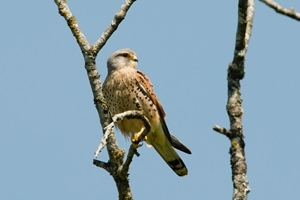 Kestrels will sometimes be seen hovering above the side of the road, keeping an eye out for their next meal, which usually consists of small rodents, particularly voles. Urban kestrels will also take sparrows. They might choose to eat lizards, worms, insects and sometimes bats for a change. They have superb eyesight, even in poor light. Kestrels will nest in holes in trees, nest boxes and cliff ledges. The film Kes is an old film about kestrels, and the book is often read in schools.
Kestrels will sometimes be seen hovering above the side of the road, keeping an eye out for their next meal, which usually consists of small rodents, particularly voles. Urban kestrels will also take sparrows. They might choose to eat lizards, worms, insects and sometimes bats for a change. They have superb eyesight, even in poor light. Kestrels will nest in holes in trees, nest boxes and cliff ledges. The film Kes is an old film about kestrels, and the book is often read in schools.
Photo credit: Markus Jenny
Barn owl
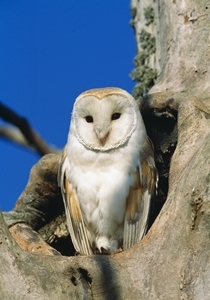 Barn owls live on field edges, in and around farmland, near water and around woodland. They need to be pretty good at hunting as, on average, a barn owl eats about four small mammals per night: that’s 1,460 per year! The most frequently taken prey is the short-tailed field vole, which usually makes up 40-80% of the diet. They will also eat shrew, mice and rats.
Barn owls live on field edges, in and around farmland, near water and around woodland. They need to be pretty good at hunting as, on average, a barn owl eats about four small mammals per night: that’s 1,460 per year! The most frequently taken prey is the short-tailed field vole, which usually makes up 40-80% of the diet. They will also eat shrew, mice and rats.
Their heart-shaped face collects sound in the same way as our ears, directing sounds into the inner ear. The sound from each ear for the owl is very different, and by analysing these differences the owl’s brain is able to calculate the exact position of the source. As a result they can locate and capture prey in total darkness.
Photo credit: Laurie Campbell
Merlin
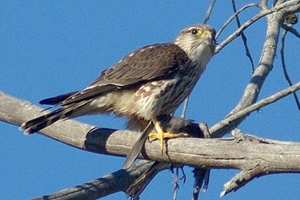 The UK’s smallest bird of prey at only 30cm long, the Merlin’s tiny size gives it a great advantage when hunting its prey, most of which is done in flight. Catching birds such as the meadow pipit, skylark and wheatear, it has to be fast and agile, swooping and diving to catch its next meal. They live in high heather moorland, although in the winter months they move to lower farm ground or even the coast. They nest on the ground in long heather, creating a shallow scrape laying four or five eggs. The female does most of the incubating of the eggs, although the male will take a turn occasionally.
The UK’s smallest bird of prey at only 30cm long, the Merlin’s tiny size gives it a great advantage when hunting its prey, most of which is done in flight. Catching birds such as the meadow pipit, skylark and wheatear, it has to be fast and agile, swooping and diving to catch its next meal. They live in high heather moorland, although in the winter months they move to lower farm ground or even the coast. They nest on the ground in long heather, creating a shallow scrape laying four or five eggs. The female does most of the incubating of the eggs, although the male will take a turn occasionally.
Photo credit: Alan Schmierer
Golden eagle
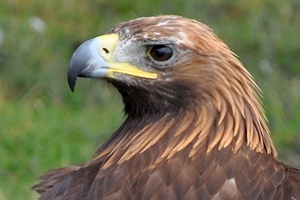 A very impressive bird mostly seen high in the sky, soaring over Scottish moorland looking for prey such as rabbits, hare, grouse, maybe a fox or even young deer. The second-largest bird in the UK after the sea eagle, it has a wingspan of 1.80m (6ft) – how tall is the tallest person in your family? Are they the height of an eagle’s wingspan? Eagles have large territories and stick to these areas for generations. Golden eagles mate for life. They build huge nests called eyries on cliff faces or in trees, which they will use for several years.
A very impressive bird mostly seen high in the sky, soaring over Scottish moorland looking for prey such as rabbits, hare, grouse, maybe a fox or even young deer. The second-largest bird in the UK after the sea eagle, it has a wingspan of 1.80m (6ft) – how tall is the tallest person in your family? Are they the height of an eagle’s wingspan? Eagles have large territories and stick to these areas for generations. Golden eagles mate for life. They build huge nests called eyries on cliff faces or in trees, which they will use for several years.
Sea eagle
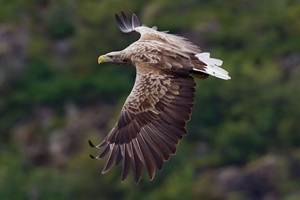 The sea eagle or white-tailed eagle is the largest bird in the UK, with a wingspan of 2m (6.5ft). Common across Scotland until 1918 when the last sea eagle was shot, they have since made a comeback. First re-introduced in 1975 to the island of Rum from Norway, and again to Wester Ross, sea eagles now breed successfully in Scotland. Fish are the main part of their diet, although they will eat carrion, rabbits, birds and lambs. They need to eat 200-600g of food per day depending on how active they are and if they are rearing young.
The sea eagle or white-tailed eagle is the largest bird in the UK, with a wingspan of 2m (6.5ft). Common across Scotland until 1918 when the last sea eagle was shot, they have since made a comeback. First re-introduced in 1975 to the island of Rum from Norway, and again to Wester Ross, sea eagles now breed successfully in Scotland. Fish are the main part of their diet, although they will eat carrion, rabbits, birds and lambs. They need to eat 200-600g of food per day depending on how active they are and if they are rearing young.
Photo credit: Yathin Krishnappa
Red kite
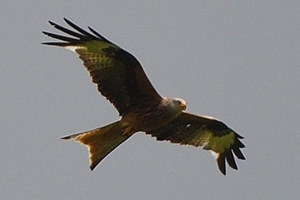 Easily distinguished by its long, forked tail, which it uses for steering in flight. Red kites are primarily scavengers, however they will also take young gamebirds and other live prey items, but they will clean a large carcass in a similar way to a vulture. Because they are a relatively weak bird, they rely on other predators to open up the tough skin, so that they can then access the soft flesh within. Decomposition also softens the dead animal’s skin, allowing kites to rip the body open themselves, devouring the putrid flesh. Just like vultures, they have highly specialised digestive systems, which produce powerful acids to neutralise rotting meat, making them resistant to bacteria such as salmonella and E. coli.
Easily distinguished by its long, forked tail, which it uses for steering in flight. Red kites are primarily scavengers, however they will also take young gamebirds and other live prey items, but they will clean a large carcass in a similar way to a vulture. Because they are a relatively weak bird, they rely on other predators to open up the tough skin, so that they can then access the soft flesh within. Decomposition also softens the dead animal’s skin, allowing kites to rip the body open themselves, devouring the putrid flesh. Just like vultures, they have highly specialised digestive systems, which produce powerful acids to neutralise rotting meat, making them resistant to bacteria such as salmonella and E. coli.
Peregrine falcon
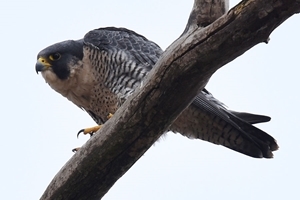 The UK’s biggest falcon, the peregrine falcon is dark grey on its back and upper wings but more pale underneath with black stripes. It has beautifully shaped wings, which help it reach its max speed of 200mph, fastest of any species on the planet. It will often hunt and catch its food from the air, such as pigeons and doves, by diving down from a great height. They mainly live in rural areas but have been more frequently spotted in cities.
The UK’s biggest falcon, the peregrine falcon is dark grey on its back and upper wings but more pale underneath with black stripes. It has beautifully shaped wings, which help it reach its max speed of 200mph, fastest of any species on the planet. It will often hunt and catch its food from the air, such as pigeons and doves, by diving down from a great height. They mainly live in rural areas but have been more frequently spotted in cities.
Photo credit: Andy Reago & Chrissy McClarren
Sparrowhawk
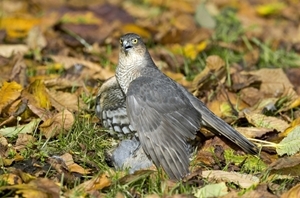 The male sparrowhawk is just a little larger than a blackbird, one of the smaller birds of prey in the UK. They have a grey back and wings with paler white/brown underneath. Sparrowhawks live in the countryside but are being seen more often in urban areas. They will spy their prey from a perch before launching at it, often choosing garden birds such as finches, sparrows and tits. They will also go after small gamebirds such as grey partridge. Swallows have a very good eye and can recognise the shadowy figure of a sparrowhawk before others so let out a big shriek that all their friends copy, alerting every bird in the area to the danger and to take cover.
The male sparrowhawk is just a little larger than a blackbird, one of the smaller birds of prey in the UK. They have a grey back and wings with paler white/brown underneath. Sparrowhawks live in the countryside but are being seen more often in urban areas. They will spy their prey from a perch before launching at it, often choosing garden birds such as finches, sparrows and tits. They will also go after small gamebirds such as grey partridge. Swallows have a very good eye and can recognise the shadowy figure of a sparrowhawk before others so let out a big shriek that all their friends copy, alerting every bird in the area to the danger and to take cover.
Photo credit: David Mason
Osprey
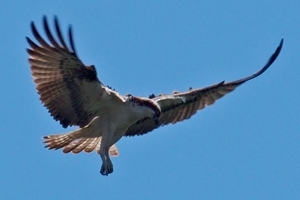 The osprey has a white head and body but looks like it wears a black eye mask. The top of its body is brown. Smaller than a golden eagle but bigger than a buzzard, and the females are larger than males. They eat mainly fish; they will fly past and swoop down onto the water, sometimes doing a shallow dive. They will also take other prey such as birds and small mammals and occasional reptiles. After breeding in the UK they fly south to Africa for the winter, often to Senegal and the Gambia. The young will stay in Africa until they are three years old before flying north to mate.
The osprey has a white head and body but looks like it wears a black eye mask. The top of its body is brown. Smaller than a golden eagle but bigger than a buzzard, and the females are larger than males. They eat mainly fish; they will fly past and swoop down onto the water, sometimes doing a shallow dive. They will also take other prey such as birds and small mammals and occasional reptiles. After breeding in the UK they fly south to Africa for the winter, often to Senegal and the Gambia. The young will stay in Africa until they are three years old before flying north to mate.
Osprey eggs were very popular to collectors, so much so that by the end of the 20th Century we had no ospreys in the UK. They returned naturally from Scandinavia in 1954 and today there are more than 200 breeding pairs in Scotland, with the occasional one to be found in England. They tend to breed with the same partner each year, returning to the same nest year after year, high in the trees, but do not stay together over the winter months. They will live for tenor more years.
Photo credit: Andreas Eichler